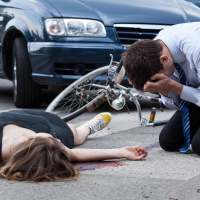LA Focuses On Pedestrian Deaths
Los Angeles Mayor Gil Garcetti just released his much-anticipated Vision Zero 2525 plan, but it will be a tough sell in the car-centric and budget-conscious city.
The initiative has the ambitious goal to eliminate traffic fatalities in eight years. Mayor Garcetti unveiled the plan in 2015, and the Los Angeles Department of Transportation, along with several other city agencies, spent most of 2016 conducting focus groups and collecting feedback on the idea. LADOT General Manager Seleta Reynolds stressed that Vision Zero is mostly about raising awareness and changing priorities from efficient traffic flow to overall roadway safety. The report also identifies 40 high-injury areas that are in dire need of physical changes; most of these locations are in south Los Angeles.
Ms. Reynolds also wants state lawmakers to redefine “jaywalking” and modify speed limit enforcement procedures.
Pedestrian-Auto Collisions in Los Angeles
Last year, there were almost as many pedestrian fatalities as all other kinds of traffic deaths (bicycle rider, motor vehicle occupant, and motorcycle rider) combined. In November 2016, voters desperate to do something about the carnage narrowly approved Measure M, which increases the sales tax to generate an estimated $120 billion over the next forty years to expand the MTA and take other measures to get people out of their cars.
Despite Mayor Garcetti’s aggressive backing, Measure M faced stiff opposition from South Bay residents because the plan prioritizes development in the northern and central parts of the city. As mentioned earlier, these are the areas where pedestrians are safer. Other voters objected to Measure M’s lack of oversight, and they predicted that the MTA’s cost overruns would derail the expansion project (no pun intended).
What Causes Fatal Pedestrian-Auto Crashes?
According to the laws of physics, speed multiplies the force in collisions between two objects, and that rule holds true in pedestrian-auto crashes. Consider the following:
| Vehicle Speed | Serious Injury Rate | Fatality Rate |
| 20mph | 25 percent | 15 percent |
| 35mph | 75 percent | 65 percent |
| 50mph | 90 percent | 75 percent |
Speed also reduces reaction time. At 20mph, most cars travel three car lengths between the moment the driver sees a hazard and the moment the car safely stops; at 40mph, that distance triples to nine car lengths.
Reducing the posted speed limits may have some effect on vehicle velocity, but not very much. Especially, in the high-risk corridors, the city will probably need to take more aggressive traffic calming measures, like installing traffic circles, widening the crosswalks and sidewalks, lengthening red light times, and changing the streets from straight to curved. Drivers will not like these measures and the money will not last. Many motorists oppose “eyesore” construction projects and wider sidewalks cost about $8 million a mile.
Common Insurance Company Defenses
Statistically, most pedestrian-auto crashes occur outside marked crosswalks, and so insurance company lawyers usually invoke the sudden emergency defense. This doctrine excuses negligent driving if the driver:
- Faced a Sudden Emergency: In the legal sense, a “sudden emergency” is a wholly unanticipated event, like a hood fly-up or a tire blow-out. Most hazards, like jaywalking pedestrians and stalled cars, do not qualify as sudden emergencies, because these situations occur on almost every trip and drivers should be ready to deal with them.
- Reacted Reasonably: It is reasonable to slow down and pull to the right after a sudden emergency, and drivers who do not do so cannot claim the defense.
Last clear chance, a companion doctrine, often applies in T-bone and rear-end crashes when one driver had the opportunity to avoid the crash but failed to take advantage of the chance. If the jury determines that the victim and tortfeasor (negligent driver) were both partially at fault, the judge will reduce the victim’s damages proportionally.

